English Version follows German.
Filmschaffende hinter der Kamera in 4 Filmgruppen 2013
Heute geht es – im ausführlicheren Text bzw. in 8 zusammenfassenden Abbildungen – um Frauen und Männer hinter der Kamera in kommerziell erfolgreichen bzw. preiswürdigen deutschen Kino- und Fernsehproduktionen, Hierfür untersuchte ich vier Gruppen von Filmen aus dem Jahr 2013: Die Top 20 Kassenerfolge im Kino, die 20 Nominierungen zum Deutschen Filmpreis, die Top 20 Fernsehfilme mit den höchsten Quotenerfolge TV, und die 17 Nominierungen zum Grimmepreis, also insgesamt 97 Filme.
Die Filmtitel – nebst Regie und Produktionsfirmen – gibt es hier: Der 4 Filmgruppen-Vergleich 2013.
Vor ein paar Wochen hatte ich bereits die Besetzung, d.h. die Frauen und Männer vor der Kamera, in diesen Filmgruppen untersucht: Kunst oder Kommerz 2013: Vor der Kamera.
Zuvor hatte ich die Datenbank von crew united ausführlicher ausgewertet: Film: Frauengewerke, Männergewerke?. Da habe ich die Frauen- und Männeranteile in 34 Teampositionen der crew united Datenbank gegenübergestellt, unterteilt in 6 Gruppen (Logistik, Idee, Bild, Look, Tuning und Spiel), und auch einen Blick auf die Wochengagen für 17 Gewerke geworfen, wie sie im Tarifvertrag festgehalten sind.
Heutige Fragestellung:
Gibt es in den vier untersuchten Filmgruppen („Kunst / Kommerz-Vergleich“) Unterschiede in den Frauen- und Männeranteilen einzelner Gewerke? Und was ergibt ein Vergleich der Statistiken der Berufsverbände und der Datenbank von crew united?
Datenmaterial:
Datenquelle sind die Webseiten vom Deutschen Filmpreis, dem Grimmeinstitut, von der FFA (Top 20 meistbesuchte Kinofilme) sowie eine Auskunft der ARD zu den Top 20 meistgesehen TV-Filmen (laut ermittelter Einschaltquote). Die Angaben zu den einzelnen Gewerken (Einzelpositionen bzw. Heads of Departments) stammen aus den Datenbanken von crew united und IMDB, von den Filmwebseiten und – um die letzten Lücken zu schließen – aus Auskünften einzelner Produktionsfirmen oder Sender.
Ergebnisse:
Am Ende dieses Textes gibt es ein Fazit und eine Bildergalerie.
Die Auswertung von Frauen- und Männeranteilen in 17 Berufsverbänden, von der Produktion über Locationscouts und den jeweils zwei Kamera- und Tonverbänden bis hin zu den Stuntleuten, sowie die Gegenüberstellung der Frauenanteile für 11 Gewerke in den Berufsverbänden und der crew united Datenbank zeigen ,typische’ Frauen- und ,typische’ Männergewerke. Die Werte beider Datenbänke liegen je Gewerk meist auf relativ gleicher Höhe, lediglich beim Szenenbild und Schnitt besteht eine Abweichung von fast 25 %. Das kann ein Anzeichen dafür sein, dass diese Teampositionen im Umbruch sind. Die crew united Datenbank würde dann den aktuellen Zustand widerspiegeln, wie es sich beispielsweise für den Schnittbereich belegen lässt: seit digital geschnitten wird sind wesentlich mehr Männer in diesen Beruf gekommen (crew united F zu M = 37,2 : 62,8 % = 1 : 1,7), dieses quantitative Geschlechterverhältnis findet sich aber noch nicht im Berufsverband (BFS F zu M = 61,9 : 38,1 % = 1 : 0,6). Möglich wäre eine umgekehrte Situation beim Szenenbild, also dass dort mehr Frauen in das Gewerk kommen bzw. Männer es verlassen. Dazu können natürlich eher Szenenbildner/innen etwas sagen.
Der 4-Filmgruppen-Vergleich ist in den beschrifteten Abbildungen der Galerie gut nachvollziehbar. Ich möchte an dieser Stelle nur drei Teampositionen hervorheben: Drehbuch, Schnitt und Regie.
Die DREHBUCHautorinnen sind in allen vier Filmgruppen unterrepräsentiert (im Vergleich zu ihren 41,7 / 36,9 % im Berufsverband / bei crew united), am deutlichsten fällt dies bei den Top 20 TV-Filmen auf (19 TATORTE, 1 POLIZEIRUF), dort wurden nur Drehbücher von Männern verfilmt. Gleichzeitig ist hier der Anteil der Produzentinnen mit 38 % überproportional hoch (Referenzwert bei crew united 26,6 %). In dem Zusammenhang wäre interessant zu erfahren, wer eigentlich beim Fernsehen über die Annahme von Büchern entscheidet, ob es die Produzent/innen sind, oder doch eher die Redakteur/innen, oder jemand Drittes? Aber das ist ein Thema für einen anderen Tag.
Im SCHNITTbereich klafft wie erwähnt die Schere zwischen Verband und crew united am weitesten auseinander, aber auch im Filmgruppenvergleich gibt es deutliche Unterschiede: Dem Frauenanteil von lediglich 4 % bei den Top Kinokassenerfolgen stehen 60 % Cutterinnen bei den Top TV Quote-Filmen gegenüber. Diese Spanne gab es bereits im Vorjahr: Keine Cutterin bei den Top Kinofilmen, mehr als 60 % Cutterinnen bei den Top TV-Filmen. (Wobei 2012 die anderen beiden Filmgruppen ebenfalls Frauenanteile um die 60 % hatten, 2013 hingegen lagen der Frauenanteil bei den Filmpreisnominierungen bei 26 % und bei den Grimmepreisfilmen bei 47 %.
Wie lässt sich das erklären? Ist der Schnitt bzw. die Arbeitsbedingungen bei High-Budget- oder Mainstream-Kinorfilmen so speziell, oder ist es reiner Zufall, dass alle 17 Regisseure und 2 der 3 Regisseurinnen ihre Filme von Männern editieren ließen? Einzige Ausnahme war Sherry Hormann (3096 TAGE), und ihre Cutterin Mona Bräuer. Oder umgekehrt, wie sind die Schnittarbeitsbedingungen (und Gehälter) im Fernsehbereich, dass dort der Frauenanteil so viel höher ist (60 bzw. 47 %)?
Aber sind diese Fragen überhaupt wichtig, wenn die Filme gut geschnitten werden und die Zusammenarbeit zwischen Regie, Kamera und Schnitt funktioniert? Vielleicht nicht. Gleichzeitig ist es aber schon merkwürdig, wenn in einer von vier Filmgruppen der Frauenanteil regelmäßig gegen null geht, und in den anderen über 50 % liegt, – und das in einem Gewerk, das in analogen Zeiten ein klassisches Frauengewerk war.
Schließlich noch ein kurzer Blick auf die REGIE: Laut Auskunft von Pro Quote Regie sind aktuell 42 von 100 Filmhochschulabsolvierenden im Fach Regie weiblich. Sowohl im Verband als auch bei crew united liegt der Frauenanteil aber gerade mal knapp über 23 %. Dieser Wert wiederum wird im 4-Filmgruppen-Vergleich nur bei den Filmpreisnominierungen erreicht. In den anderen Gruppen inszenierten deutlich weniger Frauen. Schlusslicht sind die Top 20 TV-Filme 2013 mit nur einer Regisseurin: Sabine Derflinger inszenierte den Wien-Tatort ANGEZÄHLT. (Das war nicht nur bei den Top 20 so, für alle Tatorte 2013 gilt ein Regisseurinnenanteil von 5,6 %). Wenn wir gleichzeitg die 0 % Autorinnen betrachten können diese Krimis schon als einseitige Formate bezeichnet werden, denn die Geschichten werden fast einheitlich aus Männersicht erzählt. Aber auch das ist ein Thema für einen anderen Tag.
Fazit:
In der deutschen Film- und Fernsehbranche lässst sich eine mehr oder weniger deutliche Unterteilung in Frauen- und Männergewerke feststellen, allerdings gilt sie in dieser Form für verschiedene Filmgruppen nicht in allen Gewerken. Eine gründlichere Untersuchung oder Umfrage beispielsweise durch die Filmverbände könnte Aufschluss über mögliche Gründe geben.
- 17 Verbände. Frauendomänen: Kostüm u Maske. Männerdomänen: Kamera, Fernsehkamera, Licht. Ton, Filmton, Stunt
- Vergleich Filmverbände / crew utd: Die Frauenanteile für Ton, Szenenbild, Schnitt unterscheiden sich um mehr als 15 %. Vermutlich ist da aktuell einiges in Bewegung
- Top 20 Kinokassenerfolge: keine Kamerafrau, keine Tonmeisterin, bei Drehbuch, Schnitt und Casting der Frauenanteil deutlich unter dem Branchenwert
- Fast überall liegt der Frauenanteil bei den Filmpreisnominierungen deutlich über denen der Kassenerfolge. Ausnahme: Musik
- Trotz überproportional vieler Produzentinnen wurde kein Drehbuch der 19 Tatorte und 1 Polizeiruf von einer Frau geschrieben, der Regisseurinnenanteil liegt bei 5 %.
- Kein Kostümbildner bei den Grimmepreisfilmen. Die Frauenanteile für Regie und Drehbuch liegen deutlich höher als bei den Krimis, allerdings immer noch unter den Branchenwerten
- Die Übersicht zeigt für die vier Filmgruppen 2013 deutliche Unterschiede für die allermeisten Gewerke. Die geringste Streuung im Maskenbild: Frauenanteile zwischen 83 und 91 %.
- 2012 fällt auf, dass alle Top Kinofilme von Männern geschnitten wurden. Aber Frauen können es auch, wie Frauenanteile um die 60 % für die 3 anderen Filmgruppen zeigen. Auch beachtlich der hohe Anteil an Kamerafrauen im TV
Give me Art, Give me Money 2013: Behind the Camera
Today’s text and 8 explanatory figures are about women and men behind the cameras in commercially succesfull and film prize worthy German cinema and television productions. For this I investigated (like in 2012) four groups of films from the year 2013: the 20 top grossing films, the 20 nominated films for all categories of the German film awards, the 20 top view TV films and the 17 films nominated for the German TV awards, that is a total of 97 films. The titles of the films can be found in this article: Comparing 4 Groups of Films from 2013.
Some weeks back I had analyzed the casts, i..e. the women and men in front of the camera, for these four groups of films: Give me Art, Give me Money 2013: In Front of the Camera.
And even before that I had investigated the data base of crew united in greater detail (Fimcrafts: Some with Women, Some with Men?. There I compared the shares of women and men for 34 team positions in the crew united database, dividing them into 6 groups: Logistics, Idea, Images, Looks, Tuning and Acts. Also I briefly mentioned the weekly wages for 17 team positions as they are described in the labour agreements of the film industry.
Today’s Task:
Are there differences to be found for the four investigated groups of films as regards the shares of women and men in 11 team positions? And what can we learn by comparing the shares of women and men in their professional associations and the crew united data base?
Data base:
The data I used was taken from the websites of the German Film Award, the Grimme Institute, of the FFA (Film Founding Assoc. – they publish the top grossing films) and an email from the ARD (,Channel 1’ German public TV) informing me about the top 20 TV films with allegedly highest audiences. The information on the 11 departments (Heads of Departments etc.) I have found in the databases of crew united and IMDB and on the websites of the films. To close the final gaps on my list I contacted production companies and TV channels.
Results:
At the end of this text you will find a short conclusion and an 8-figures-galery.
An evaluation of the shares of women and men for 17 professional associatons, ranging from production via location scouts, camera people and sound technicians (2 associations each) to stuntpeople, as well as comparing the shares of women for 11 team positions in associations and the data base of crew united showed ,typical’ female and ,typical’ male film departments. The figures of both databases are pretty similar, except for set production and editing, which differ by nearly 25 %. This could indicate an ongoing change. In that case the crew united database would reflect a more recent condition, as is apparent in film editing, where since the introduction of digital editing more men are working in this profession (crew united F to M = 37,2 : 62,8 % = 1 : 1,7), this gender ratio we do not find yet in the editors’ professional association (BFS F to M = 61,9 : 38,1 % = 1 : 0,6). Quite possibly we encounter the opposite development in set production, i.e. more females are entering this line of work and / or more men are leaving it. But this is something that set producers are more qualified to talk about.
The 4-groups of films-comparison is quite comprehensible from the 8 commented figures in the galery. So at this point I would just like to highlight three areas: script, editing, direction.
Female SCRIPT WRITERS are underrepresented in all four groups of films as opposed to their share of 41,7 / 36,9 % in their association / crew united database. This is most distinct for the Top 20 TV movies (19 TATORT, 1 POLIZEIRUF, all cop movies), where we find only scripts by male writers. At the same time, the share of female producers is above average (38 %, as opposed to 26,6 % in crew united). It would be interesting to find out who or what TV department decides which scripts are to be turned into films, is it the producers, or rather the commissioning editors, or someone else? But that is really a topic for another day.
For EDITING I already mentioned the gap in the figures of the professional association and the crew united database. But maybe even more noteworthy is the fact that the editing figures for the four film groups are quite dissimilar, in fact one number stands out, the 4 % females among all editors of the top 20 box office successes. On the other end of the scale we get a 60 % female share for the top 20 TV successes. Something similar can be found in the 2012 statistics: not a single female editor for the to box office films, more than 60 % for the top TV films. So who can explain that? Are the editing or the working conditions for high budget or mainstream movies so particular, or is it just a coincidence, that all 17 male directors and 2 of the 3 female directors chose men to edit? Only exceptino being Sherry Hormann (3096 TAGE), and her editor Mona Bräuer. Or looking at it from the other side: what are the editors’ working conditions (and wages) like in TV, that we get much higher shares of women there (60 and 47 %)?
But do these questions really matter, as long as the films are editing well and the cooperation between directing, camera and editing runs smoothly? Maybe not. At the same time it is a bit strange that we have a nearly 0 % women film group in a department that used to be a typical women’s film job in days before the digitalization, next to three film groups with at least half the editing staff being female.
And finally a quick glance at the directors: According to Pro Quote Regie 42 of 100 directing graduates at German film schools are female. But for the professional association as well as the crew united database we only find shares of roughly 23 %. And this figure can only be found once in the four film groups: among the directors of nominated films for the German film awards. In the other groups the shares of female directors are much less. At the end find the top 20 TV movies 2013 with only one female director: Sabine Derflinger directed ANGEZÄHLT, a TATORT from Vienna. When we think of the 0 % female authors in this film group then we really need to call this show partial, since nearly all stories are told and interpreted from a male point of view. But that is a topic for another day.
Conclusions:
We can make out a more or less distinct separation of mainly female / mainly male tema positions in the German film and TV industry, although this can vary considerably in different groups of films for individual departments. Maybe a more thorough investigation or survey, e.g. undertaken by the professional film associations, could help finding possible reasons for these phenomena.
- 17 professional associations. Female departments: costume and make-up design. Male division: camera, TV camera, light, sound, film sound and stunt
- Despite a high proportion of female producers no script of the 20 films with highest audiences (all cop dramas) was written by a woman. The share of female directors was only 5 %.
- Comparing all 4 film groups for 2013 distinct differences occur for most departments. The smallest differences can be found in the make-up dept: share of women between 83 and 91 %.
- For nearly every department the share of women is higher for the film prize nominations than for the top grossing films. Exception: music dpt
- The TV awards films had no male costume designers. The shares of women for direction and script was much higher than for the TV highest audience films
- In the 20 top grossing films there were no female DoP’s or heads of sound dpt., for script, sound and casting the share of women was clearly below average
- The figures for 2012 show that all top grossing films were edited by men. Of course women edit films as well, in all other three groups the female editors were around 60 %. Also worth noting is the high share of camerawomen for the TV groups
- Comparing prof. assocs. and crew utd database: The shares of women for sound, set production and edition differ with more than 15 %. Sign of a change?

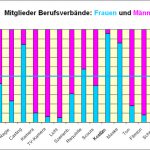
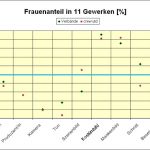
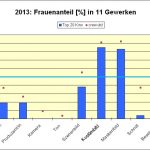
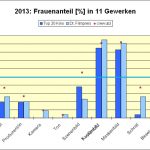
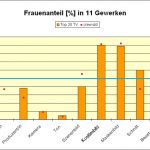
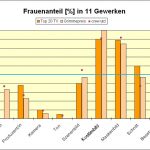
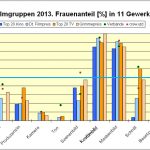
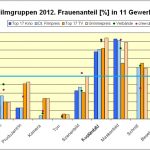

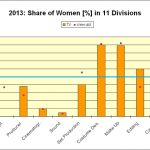
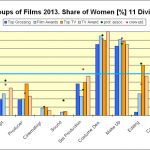
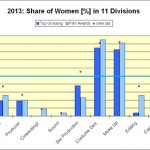
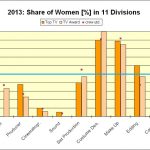
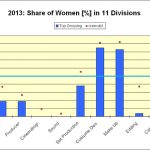
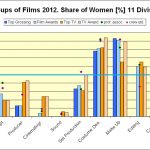
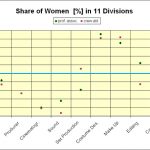
Pingback: Kann die Filmbranche von der BVG lernen? – Can Berlin’s Public Transport be an Example for the Film Industry? | SchspIN
Pingback: Zwei Jahre SchspIN: Ein Rückblick – Two Years SchspIN: Best Of | SchspIN
Pingback: Kann die Filmbranche von der BVG lernen? – Can Berlin’s Public Transport be an Example for the Film Industry? | SchspIN
Pingback: Geschlechtergerechtigkeit beim Film – Gender Equality & Film Industry | SchspIN
Pingback: Schauspiel und Fair Pay & Acting | SchspIN
Pingback: Grimmepreis: 7 Gewerke, 7 Jahre – German TV Award: 7 Divisions, 7 Years | SchspIN